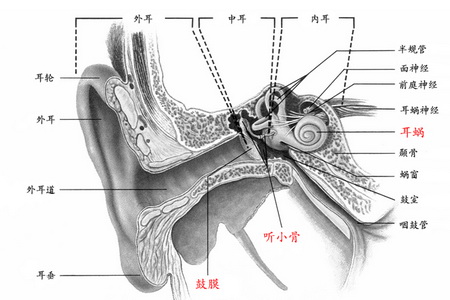A random survey of students at Purdue University in the United States shows that more and more people have a pair of old ears on their young heads - in academic terms The number of people with mild noise-induced hearing loss (NIHL: Noise-induced Hearing Loss) is increasing year by year. What is noise hearing damage? In short, it is a condition in which the ear has suffered too much sound for a long period of time, and thus the hearing is declining. The decline in hearing was originally only a patent for the elderly. The reason why it has become a commonplace for young people, the Walkman and the headphones may not be able to escape! Our ears can be roughly divided into three areas as shown above: the outer ear, the middle ear and the inner ear. The three parts most closely related to hearing are the tympanic membrane between the outer ear and the middle ear, the ossicle in the middle ear, and the cochlea in the inner ear. An acoustic signal is emitted from the sound source. When the external auditory canal reaches the tympanic membrane, the extremely thin and sensitive tympanic membrane can transmit the vibration of the acoustic wave to the ossicle. The small bone is made up of the three smallest bones of the human body: the hammer bone, the anvil and the tibia. These three bones are similar to a lever system: the hammer bone is directly connected to the tympanic membrane, the vibration of the tympanic membrane directly drives the movement of the entire ossicular system, and the vibration extends through a small opening (oval window) on the cochlea into the liquid-filled Inside the cochlea. The hair cells responsible for different frequencies in the cochlea convert the vibration into electrical signals at the microvolt level, and the electrical signals are transmitted through the nerve fibers to the auditory nerves in the brain. Although the whole process is very complicated, we don't feel any delay due to the high configuration of the processor. When in a high-decibel sound environment for a long time, the most direct damage is the inner ear, high-pitched sound or noise constantly impacts the liquid in the cochlea, causing the hair cells to die due to excessive stimulation. The metaphor of an image is that when we "enjoy" more than 100 decibels of music, the hair cells are like dead grass that is constantly crushed by the roller and slowly die. In the long run, the hearing level of this frequency band will drop sharply after the hair cells in a certain frequency band are seriously damaged. According to the US Occupational Safety and Health Administration, sounds above 85 decibels can be included in the noise. In fact, many people can stand up to listening to music for more than 90 decibels for a long time without knowing it. Many people like to listen to songs in the subway, bus or in a noisy environment, which naturally makes the volume of the headphones too large. In one study, the researchers found that when the ambient volume reached 65 decibels, the subject chose to turn the volume of the headphones up to 82 decibels for better results. This number may be higher when the ambient volume is higher. In the long run, even in a quiet room, the headset user will still set the volume to a standard far exceeding the actual needs. Even more frightening is that playing too loud a volume for a long time does not bring immediate pain. For the average person, headaches, pains, and pain in the ears, why bother to pay attention? In most cases, noise-induced hearing damage is caused by tiny damage that has accumulated for a long time. Therefore, it is recommended that headset enthusiasts should master a "60-60 principle", which is also an internationally recognized method of protecting hearing. That is, when listening to music, the volume should not exceed 60% of the maximum volume, and the continuous listening time should not exceed 60 minutes. It is healthier to use the ear in such a situation. When buying headphones, you may want to pick some headphones that can block external noise to reduce the chance of increasing the volume of the Walkman due to environmental noise. Headphones are best chosen to be head-mounted, which has less damage to hearing than earbuds. Because the earphones are directly plugged into the external auditory canal, the sound is not from the source, and it is sent toward the tympanic membrane. The sound is completely received by the tympanic membrane, which is more harmful to hearing. In general, listening to music of the same volume, the volume of the earphones is 7-9 dB higher than that of the headphones. Usb Docking Station,Usb Hub Docking Station,Docking Station With Hdmi,Usb C Hub Laptop Docking Station Shenzhen GuanChen Electronics Co., Ltd. , https://www.gcneotech.com

May 23, 2023